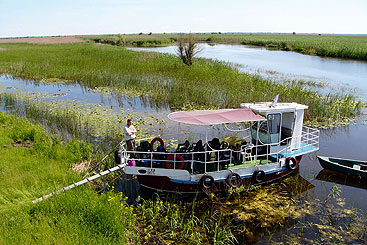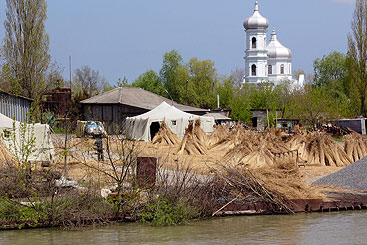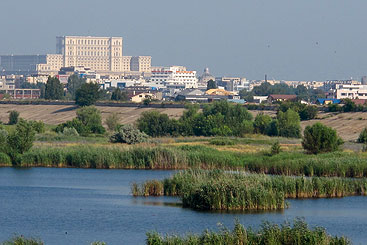Better understanding of wetlands
Wetlands connect us all, upstream-downstream along the rivers. A recent
conference organised in the Danube River Basin brought together participants
from all over the world to find sustainable solutions to protect these
valuable ecosystems.


The captain of a tourist boat in the Romanian Danube Delta Ramsar site waits for his international visitors to return from a particularly interesting birdwatching spot.
Rivers, lakes, marshes and floodplains form a network of water-related ecosystems. In the 1960s, the term ‘wetlands‘ was created to streamline the new focus on these hitherto neglected ecosystems and their values. Wetlands take care of water - they provide the natural infrastructure to capture, filter, store, transport and release water. Wetlands are critical arteries of the water cycle that keeps us supplied with water. Sustainable river basin development depends therefore on the maintenance of the services provided by its wetlands.
Wetlands were the focus as 900 participants from all over the world gathered on 4–13 July 2012 in Bucharest, Romanian capital for the triennial conference of the parties (COP11) to the Ramsar Convention on Wetlands. This was the first time a global conference on wetlands was hosted in the Danube Basin, and provided an opportunity to showcase the work undertaken by the ICPDR and its partners for integrated river and ecosystem management along the Danube and its tributaries, and to learn from experiences in other river basins.
Delegates debated globally relevant themes, such as the functions of wetlands for flood retention, water treatment, recreation and the improvement of the local climate in urban environments, the role of wetland services and products to alleviate poverty and to improve local economies, as well as the importance of integrated ecosystem management for water security and sanitation. This latter was also covered in the new ‘Ramsar Wetland Disease Manual’, indicating how to create healthy wetlands for healthy people.
Wetlands and river basin management. Of particular relevance to river basin managers was the resolution adopted on wetlands and energy issues. This stresses the interrelations between environmental risks, the need for transparency and the social responsibility of river basin planning and management. It also highlights the need to undertake strategic environmental assessments, such as for navigation and hydropower infrastructure that may substantially alter the hydromorphology of rivers and their sediment transport.

Reed harvesting can support sustainable local economies, such as in Vilkovo, situated in the Ukrainian Ramsar site along the Kylia Branch of the Danube River.
In the current context of a changing climate, sectoral policy decisions in the fields of energy production, transport, agriculture, water provision and others are likely to have cumulative impacts on ecosystem services and the water resources that depend on them – impacts that are often still underestimated and not sufficiently taken into account.
Sharing difficult decisions. The delegates did not make any revolutionary decisions, but they spent long hours discussing how to cope with ongoing climate change (regarding carbon sequestration in wet forest ecosystems) and sustainable ways of producing healthy food with minimum pesticide use for an ever growing population (in irrigated rice paddies) – both of which are difficult subjects to obtain a global consensus and where the debate will continue in upcoming multilateral environmental conferences.
However, the outcomes of the Ramsar conference show that environmental problems cannot be managed any longer in isolation. Sustainable solutions need to be based on intergovernmental – and interministerial – policies which integrate energy and food production, water security, sanitation, public health and others, and are based on the maintenance and sustainable management of the ecosystems and their products upon which we all depend.

A rich wetland ecosystem developed in the Vacaresti water retention polder at the edge of Romania’s capital of Bucharest. The site is within viewing distance of the Palace of Parliament where the Ramsar Conference of the Parties took place. Vacaresti will hopefully become an urban wetland recreation and education area.
The Bucharest message. The stark message from the conference is the need for intersectoral cooperation as a prerequisite for successful work in the water sector. And that is a message with which the partners in the Danube Basin can easily agree.
Wetland experts in the Danube Basin have shown that they can work well with water engineers through their cooperation over the second assessment of transboundary rivers, lakes and groundwater, prepared by the UNECE Water Convention with support from Ramsar.
From the DANUBEPARKS network, composed of protected areas along the river listed as ‘Wetlands of International Importance’ under the Ramsar Convention, to the impressive number of ecological restoration projects in the region and the pioneering ‘Joint Statement on Navigation and Environmental Protection’, the Danube Basin served as an appropriate background to host an international meeting on water-related ecosystems. Cooperation between the water and nature sectors has a promising future, particularly in the Danube Basin.
This potential was also illustrated by the theme of the conference ‘Wetlands: Home and Destinations’, focusing on the role that wetlands play for recreation and tourism. A special publication, ‘Destination Wetlands’, was launched for the occasion by the UN World Tourism Organization and Ramsar and highlights 14 wetland tourism case studies from across the world, including the Danube Delta and Skocjan Caves Ramsar sites in the Danube Basin.
To download a copy of that publication, please visit: www.ramsar.org/tourism.





